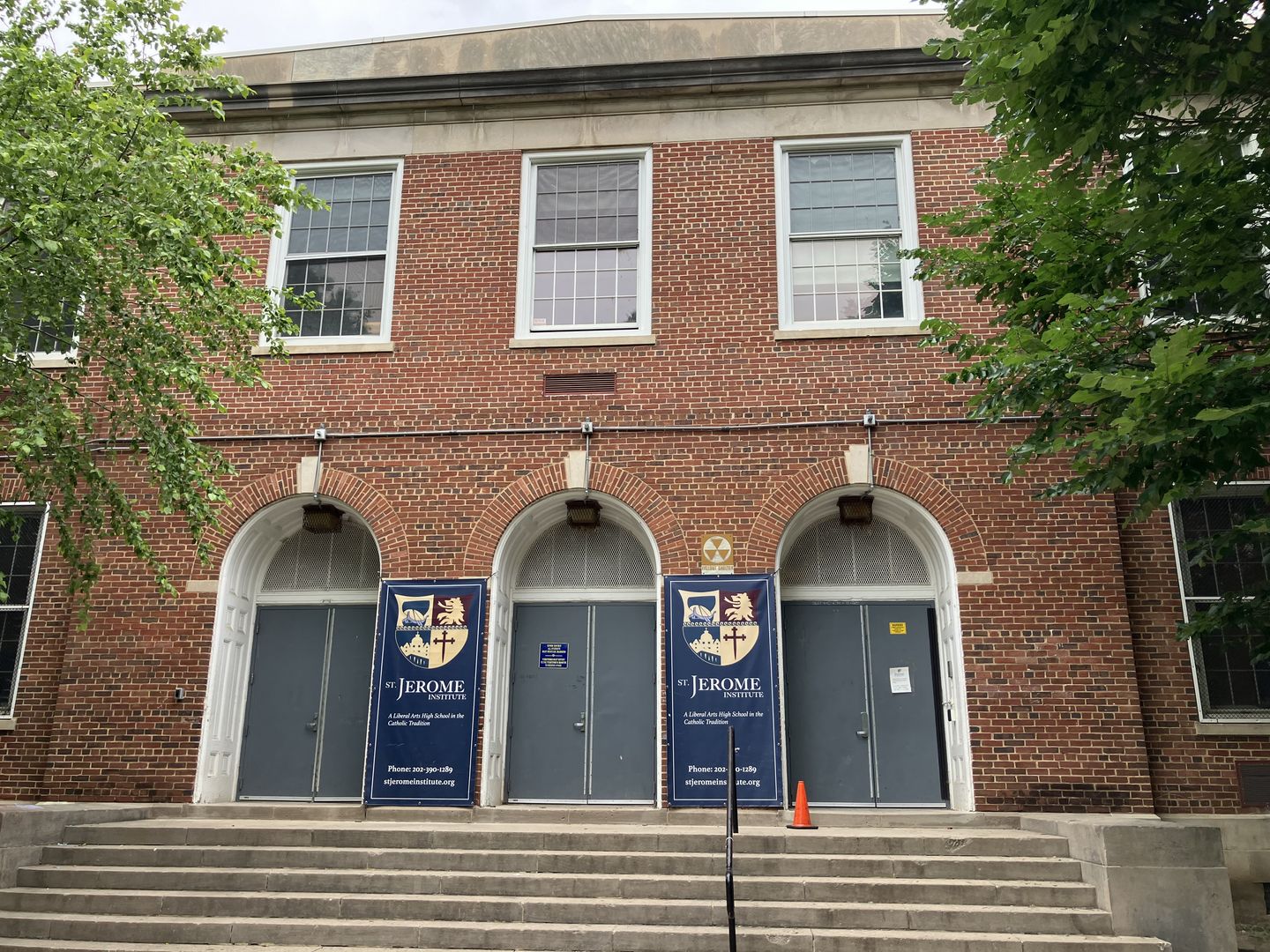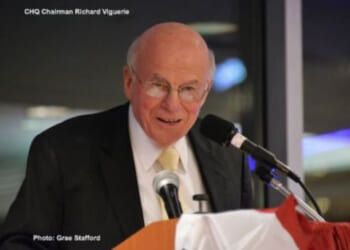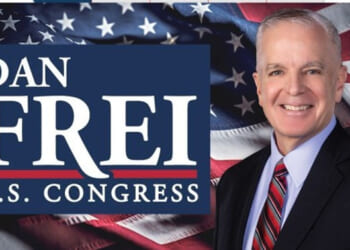
Many high schools have developed curricula to address modern issues such as artificial intelligence, social media and green technology. But a one-of-a-kind school run by Catholics in Northeast Washington is aiming to secure the future by embracing the past.
And for senior Magdalena Reminga, the classical education offered by St. Jerome Institute has made all the difference. Painfully shy when she arrived four years ago, she’s now preparing to attend Hillsdale College and become a speechwriter after having debated the works of Homer, Dante and Shakespeare at the tiny campus.
“The teachers encouraged me to ask questions and drew me out of myself,” said Ms. Reminga, 18. “I learned how to disagree and push back in discussions. It’s a beautiful feeling of camaraderie in Christ.”
She’s one of 10 students graduating Monday from St. Jerome Institute, which was established in 2019 by Catholic homeschoolers struggling with a lack of traditional education options in the Archdiocese of Washington.
The archdiocese, which oversees the District and suburban Maryland, is now vetting St. Jerome for approval as one of a small number of “independent” Catholic schools run by non-clergy.
St. Jerome, which occupies a wing of Perry Street Prep Charter School, has grown steadily from three students in its first year to 65 this year. More than eight in 10 of its students are Catholic, with the others coming from Protestant denominations attracted to the school’s classical education.
“We reject any Marxist, woke ideologies that reject the full dignity of man created in the image of God,” said Institute President Andrew Shivone. “Our concern is to be wholly Catholic, first and foremost, and to follow the teaching of Christ in every aspect of our lives.”
The institute recently announced plans to relocate to an unused school building at St. Hugh of Grenoble parish in Greenbelt, pending approval from Prince George’s County officials.
Graduating senior Liam Duggan, who plans to study technology at the University of Maryland, College Park, says the institute’s seminar-style classes helped him think for himself. He expects to attend Mass at least weekly while studying at his state’s flagship public university.
“Going forward, if I hadn’t gone to this school, I could see my relationship with God falling apart,” Mr. Duggan said. “When I ask a question, the teachers help me talk through it and answer it myself rather than just give me the answer.”
St. Jerome, which charges $18,000 a year in tuition, bears similarities to other Catholic high schools: Students attend Mass regularly, and a priest offers spiritual counseling weekly.
The curriculum covers math, science, physical education, fine arts and music. Extracurriculars include choir, theater, boys’ soccer, girls’ volleyball, boys’ flag football and cross country.
But the institute relies almost entirely on primary sources and offers no Advanced Placement classes. Artificial intelligence is frowned upon, cellphones are forbidden on campus and classes resemble university seminars rather than rows of desks with students slumped over them.
“The order and structure of the curriculum is unique,” said Lauren Gramlich, St. Jerome’s development director and assistant choir director. “We cover everything the archdiocese mandates and all of our classes are honors level. We’re just not covering it in the same way.”
Teaching virtue
Church music, Latin recitations and a spirited debate about the meaning of virtue echoed through the institute’s wooden hallways on a recent Tuesday afternoon.
In one junior humanities classroom, a male student asked a female classmate: “Are you saying the only way to know the good is through the emotions?”
“I just don’t like the idea of love being purely intellectual,” she replied.
Teacher Max Bindernagel, who also serves as the institute’s dean of students, gently guided 13 students in the discussion as they faced each other around long tables. He cited class readings from C.S. Lewis, Plato and Thomas Aquinas as touchstones.
“You can choose to love someone even though you’re not feeling it,” Mr. Bindernagel said. “What I would say is that almost anything and everything we do is going to involve the whole person, body and soul. I’ve got to be honest with you, Plato would have a hard time philosophizing if he had a toothache.”
Most of St. Jerome’s 15 teachers, including Mr. Bindernagel and Mr. Shivone, double as administrators.
Students in each grade level circle up daily for a two-hour humanities course that mixes literature, art, theology, philosophy and poetry with reading, history and writing.
The integrated curriculum presents the Western intellectual tradition in the light of Catholic revelation. For example, students in the freshman humanities seminar read about a shipwreck in Homer’s epic poem “The Odyssey” while studying oceanic navigation in science class and the journeys of Moses in the Book of Exodus.
“Everything about the school assumes that the Catholic Church is teaching the truth about reality,” said Michael Higgins, an institute theology teacher who previously taught at Georgetown University and Loyola University Maryland. “We’re trying to bring students into communion with reality, God, the church and each other. It’s oriented toward teaching them to love more deeply.”
While the campus has a designated room for after-school detention, there are few discipline issues. Officials attribute that partly to spontaneous “poetry battles” in which students storm other classrooms on any given day to recite verses from memory.
For example, one class will charge into a neighboring room to proclaim an Emily Dickinson poem, pushing their classmates to respond with Alfred Lord Tennyson.
Faculty members say the spontaneous clashes offer an outlet for competition and aggression that motivates students to learn the poems they’re studying in class.
They say the emphasis on great literature also frees the school from partisan politics, helping students speak freely about big issues.
For example, a May production of Shakespeare’s “Julius Caesar” used modern costumes but stopped short of including references to current politics to illustrate the play’s themes of demagoguery, polarization, uncertainty and fear in a republic obsessed with its past.
“I wanted to do Caesar and be aware of how those things are relevant, but without giving the senators bright red ties to suggest they are Republicans,” said Alexi Sargeant, who directs student plays and teaches the sophomore art history seminar. “It’s a play with a lot of warnings and questions, and no easy answers. It’s not about Trump.”
According to Mr. Sargeant, who holds a theater degree from Yale University, St. Jerome Institute’s purpose is not to “equip students to be Republican operatives or Democratic operatives.”
“In my view, it’s about forming citizens with rightly ordered souls,” he said. “It’s conservative in the best sense of preserving the reading of great books in the light of Christ, but liberal in the best sense of liberating people to be free citizens. The irony is that it feels like we’re less dogmatic than most public schools.”
Fighting for recognition
St. Jerome has sought to expand on a recent trend of Catholic laypeople seeking official recognition for grassroots classical schools.
Parents at St. Jerome parish in Hyattsville started the high school after their pastor told them there was no room to expand the campus of St. Jerome Academy, a classical education grade school.
Traditionally, bishops and religious orders of priests or nuns have started Catholic schools, making campuses founded by parents a rarity.
Officials at the Archdiocese of Washington confirmed that they have worked with St. Jerome to lease the unused school building at St. Hugh of Grenoble parish.
“The Roman Catholic Archdiocese of Washington and its parishes support the growth of Catholic schools in the area where St. Jerome Institute is located, including both parish schools and independent or lay-run schools,” archdiocesan spokesperson Paula Gwynn Grant told The Washington Times. “We welcome opportunities to work with other institutions to promote Catholic education for our youth.”
Ms. Grant pointed to the Mother of God School, the Avalon School and the Mother Catherine Academy in Maryland as previous examples of lay-run independent Catholic schools the archdiocese has recognized.
She noted that St. Jerome Institute remains a school “in the Catholic tradition” until it gains formal approval as an “independent Catholic school.”
The institute has received mixed signals from Catholic leaders.
Mary Pat Donoghue, a former parochial school principal who turned the failing St. Jerome Academy into a thriving classical school, now leads the education arm of the U.S. Conference of Catholic Bishops.
She delivered the keynote address at the St. Jerome Institute’s annual fundraising gala in 2023, praising its families for seeking to expand the model to high schools.
But some families say that Cardinal Robert McElroy, who became archbishop of Washington in March, has made them nervous due to his past hostility toward homeschoolers.
As bishop of San Diego, Cardinal McElroy banned homeschooling co-op groups last year from using parish facilities in the California diocese. His policy warned that homeschoolers attempting to create formalized schools could “undermine the stability of nearby Catholic schools and lead people to think that the Church is approving and advancing particular alternative schools and programs.”
According to Kimberly Begg, a past donor and adviser to St. Jerome Institute, it’s no secret that Catholic schools with a classical model understand their purpose differently from “watered-down” parish schools that have been closing for decades.
“The secular, government-run schools and the parochial schools that mimic them understand the purpose of education as college and career readiness,” said Ms. Begg, president of the Clare Boothe Luce Center for Conservative Women. “The schools with long wait lists and happy families understand the purpose of education as preparing kids for eternal friendship with Jesus in heaven.”
Ms. Begg recently co-wrote the book “The Catholic School Playbook” with technology investor Michael Ortner, a St. Jerome board member and donor. It tells the stories of Catholic schools that have grown substantially in recent years since adopting a classical curriculum.
“It’s rooted in an understanding that objective truth exists, that you can seek it out and that you can understand it,” Ms. Begg said. “Anytime you teach kids that truth is relative, you add an element of confusion that makes it harder for them to pursue and live faith in a meaningful way.”












